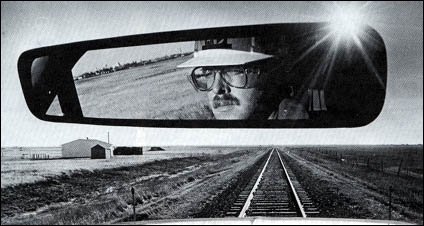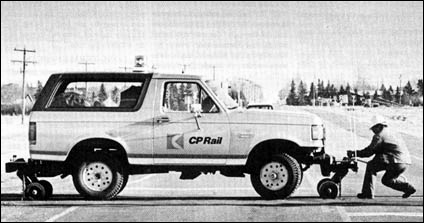Vol. 18 No. 2
February, 1988
|
Make Tomorrow Happen
|
Rubber-Tired Technology Betters Roadmaster's Busy Work
Day By Janice Fjeldsted

Wilkie Saskatchewan - "I've been working on the railroad" has
a special meaning for Jim Groves. He can often be found doing just that.
Since 1985, Jim has been roadmaster at Wilkie, a community of 1,600 located 160 kilometres northwest of Saskatoon. It
was here that he became acquainted with the new era of rubber-tired technology that has changed the way
he works.
The new era arrived not long ago in the form of a Ford Bronco 3/4-ton "Hi-rail".
It's a standard truck in every way but one - it's equipped with rail wheels.

Trouble Shooter
The work day starts early for Jim, and may find him travelling to the likes of Lloydminster or Kerrobert,
troubleshooting along the way.
His territory comprises 490 kilometres of track on five branch lines in Saskatchewan. And that means travelling a lot
of solitary kilometres. But, says Jim, it's not so bad. "I may be travelling alone, but I always know I'll be
meeting someone along the line".
A typical day starts at 7 a.m. On days he's out checking his territory, he stops by the office first to assign work
to his staff, do some paperwork, answer phone calls, and get clearance from the dispatcher to head out on one of the
lines.
Then he travels by highway to a railway crossing. He positions his vehicle on the rail line, lowers the steel wheels
and locks them in place. Then he's off down the line, miles of lonely track stretched out ahead.
Not far down the Reford subdivision, Jim stops to check a kink in a rail. "This is one of the trouble spots on
the line", he says.
"There are 21 sink holes on the Reford. They cause the rail to sway out of line. The problem is that the old
foundation put in many years ago stayed wet and never stabilized. We've lifted the rail three times this year to
repair it, but we obviously have more work to do".
Never Idle
A little farther along, Jim spots another recurring problem - someone has cut through the fence along the track.
Reaching the diamond where the line crosses the CN mainline, Jim stops to throw a switch that trips warning signals
to oncoming trains, and waits five minutes to ensure it's safe to pass through the crossing.
But instead of waiting idly for the five minutes to pass, he takes the opportunity to tighten some joints on the
diamond.
"This diamond is one of my biggest headaches. Since we're the junior railway at the crossing, it's up to us to
maintain it. That means about 60 manhours a month".
Continuing on, he stops to talk with trackmen, inspect a fire extinguisher in a trackside shed, tighten more rail
joints, and inspect another sink hole, making notations in his ever-present notebook along the way.
Just outside Kerrobert at the end of the Reford subdivision, he transfers the Hi-rail back to the
highway and heads for home.
Jim says the Hi-rail has made a big difference in the way he handles his territory, where four of the
five lines are dead ends. Before he got the Hi-rail, he travelled in a track motor car, backing up all
the way to Wilkie when he reached the dead ends.
"That was very time-consuming. When my area was increased from 167 miles (268 km) to 304 miles
(490 km) in January of 1987, I just wouldn't have had the time to properly inspect each line without the
Hi-rail.
Frequent Checks
Jim travels each line at least every 10 days. The remaining days are spent in his office in Wilkie, and a good deal
of the that time is devoted to safety.
"We think our safety program has been very beneficial", he says. "We do a lot of reviewing of injuries
that can and do happen, and how to prevent them. Last year Saskatoon was the worst division safety-wise
- now we're number one", he says with pride.
Another workday behind him, Jim heads home to his wife, Cathy, and their children, Michelle, 7, Geoff, 4, and Karen,
9 months.
Spare Time Rare
With the family, his involvement with the Elks, and the local volunteer fire department, there is little time left
for relaxation. When he does find some "spare" time, Jim enjoys woodworking, his involvement in a bottle
collecting club, and sports of all kinds.
"Wilkie is a friendly railway town, with good schools for the kids and lots of community involvement",
says Jim. "If only there were more hours in the day".
This CP Rail News article is copyright
1988 by the Canadian Pacific Railway and is reprinted here with
their permission. All photographs, logos, and trademarks are the property of the Canadian Pacific Railway
Company.
|